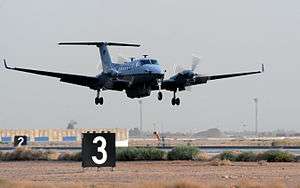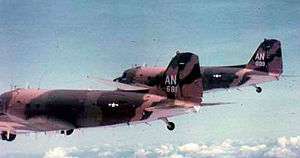361st Expeditionary Reconnaissance Squadron
| 361st Expeditionary Reconnaissance Squadron | |
|---|---|
 MC-12 Liberty lands after a combat sortie | |
| Active | 1943–1945; 1966–1971; 1972–1974; 2007; 2010–2014 |
| Country |
|
| Branch |
|
| Role | Reconnaissance |
| Part of | United States Air Forces Central Command |
| Engagements |
European Theater of Operations[1] Global War on Terror |
| Decorations |
Presidential Unit Citation Air Force Meritorious Unit Award Air Force Outstanding Unit Award with Combat "V" Device Air Force Outstanding Unit Award Vietnamese Gallantry Cross with Palm[2] |
| Insignia | |
| 361 Expeditionary Reconnaissance Sq emblem |
 |
| World War II squadron fuselage code[3] | B |
The 361st Expeditionary Reconnaissance Squadron is an inactive United States Air Force unit. Its last was assigned to the 451st Air Expeditionary Group, stationed at Kandahar Airfield, Afghanistan. It was inactivated on 1 September 2014.
History
World War II
The squadron was first activated at McCook Army Air Field, Nebraska, in November 1943 as the 861st Bombardment Squadron, one of the original squadrons of the 493d Bombardment Group. At McCook, the squadron began training with the Consolidated B-24 Liberator. On 1 January 1944 the 861st, less its air echelon, was transferred on paper to the European Theater of Operations.[1][4]
In England, new ground personnel were assigned. In mid-April they moved to the squadron's permanent station at RAF Debach, where they were joined by the air echelon, which had completed its training, in May. The unit began operations, chiefly against industrial and military installations in Germany, including an ordnance depot in Magdeburg, marshalling yards near Cologne, synthetic oil plants at Merseburg and factories in Frankfurt.[4]

Strategic operations were interrupted in the late spring 1944 buildup for Operation Overlord, the invasion of Normandy, when the group struck artillery batteries. The group also hit enemy positions near the front in Operation Cobra, the breakout at Saint Lo in July. In September the squadron converted to the Boeing B-17 Flying Fortress and bombed fortifications to support Operation Market Garden, airborne attacks in the Netherlands. It attacked German lines of communications during the Battle of the Bulge from December 1944 through January 1945 and in Operation Varsity, the airborne assault across the Rhine in March 1945.[1][4]
The squadron flew its last combat mission on 20 April 1945, when it struck marshalling yards at Nauen. The squadron redeployed to the United States in August for possible service in the Pacific, but following VJ Day, inactivated at Sioux Falls Army Air Field on 28 August.[4]
Vietnam War

Activated in South Vietnam in 1966. Flew EC-47 aircraft equipped with electronic countermeasures equipment over South Vietnam. Reassigned to Thailand in 1972 as part of USAF draw-down in South Vietnam. Continued missions over Indochina until 15 August 1973 when United States military flights over Indochina halted by congressional mandate. Trained in Thailand until inactivation on 30 June 1974.
Global War on Terror
The squadron reactivated as the 361st Expeditionary Reconnaissance Squadron as part of the Global War on Terrorism in 2003. Assigned to the first the 407th Air Expeditionary Group, then later the 451st Air Expeditionary Group, the squadron operated a variety of Intelligence, Surveillance & Reconnaissance aircraft before the United States pullout from Iraq in 2011 and Afghanistan in 2014.
Lineage
- 861st Bombardment Squadron
- Constituted as the 861st Bombardment Squadron (Heavy) on 14 September 1943
- Activated on 1 November 1943
- Redesignated 861st Bombardment Squadron, Heavy on 21 February 1944
- Inactivated on 28 August 1945[1]
- Consolidated with the 361st Tactical Electronic Warfare Squadron as the 361st Tactical Electronic Warfare Squadron on 19 September 1985[5]
- 361st Reconnaissance Squadron
- Constituted as the 361st Reconnaissance Squadron and activated on 4 April 1966
- Organized on 8 April 1966
- Redesignated 361st Tactical Electronic Warfare Squadron on 15 March 1967
- Inactivated on 1 December 1971
- Activated on 1 September 1972
- Inactivated on 30 June 1974[5]
- Consolidated with the 861st Bombardment Squadron on 19 September 1985[5]
- Redesignated 361st Expeditionary Reconnaissance Squadron and converted to provisional status
- Activated c. December 2007
- Inactivated unknown
- Activated 1 May 2010
- Inactivated on 1 September 2014
Assignments
- 493d Bombardment Group, 1 November 1943 – 28 August 1945[1]
- Pacific Air Forces, 4 April 1966 (not organized)
- 460th Tactical Reconnaissance Wing, 8 April 1966[6]
- 483d Tactical Airlift Wing, 31 August 1971 – 1 December 1971[7]
- 56th Special Operations Wing, 1 September 1972 – 30 June 1974[8]
- Air Combat Command to activate or inactivate as needed
- 407th Air Expeditionary Group, c. November 2007 – unknown
- 451st Air Expeditionary Group, 20 May 2010 – 1 September 2014
Stations
- McCook Army Air Field, Nebraska, 1 November 1943 – 1 Jan 1944
- Elveden Hall (Station 116),[9] England, 1 January 1944
- RAF Debach (Station 152),[9] England, 17 April 1944 – 6 August 1945
- Sioux Falls Army Air Field, South Dakota, c. 13–28 August 1945[1]
- Nha Trang Air Base, Republic of Vietnam, 8 April 1966
- Phù Cát Air Base, Republic of Vietnam, 1 September 1969 – 1 December 1971
- Nakhon Phanom Royal Thai Air Force Base, Thailand, 1 September 1972 – 30 June 1974
- Ali Air Base, Iraq, c. November 2007
- Kandahar Airfield, Afghanistan, 20 May 2010 – 1 September 2014
Aircraft
- Consolidated B-24 Liberator, 1943–1944[1]
- Boeing B-17 Flying Fortress. 1944-1945[1]
- Douglas C-47 Skytrain, 1967-1971, 1972-1974
- Douglas C/EC-47H Skytrain, 1967-1971, 1972-1974
- Beechcraft MC-12W Liberty, 2010-2014
See also
References
- Notes
- 1 2 3 4 5 6 7 8 Maurer, Combat Squadrons, pp. 785-786
- ↑ "Air Force Personnel Services: Unit Awards". Air Force Personnel Center. Retrieved April 29, 2017. (search)
- ↑ Watkins, p. 122
- 1 2 3 4 Maurer, Combat Units, pp. 362-363
- 1 2 3 Department of the Air Force/MPM Letter 662q, 19 September 85, Subject: Reconstitution, Redesignation, and Consolidation of Selected Air Force Tactical Squadrons
- ↑ Ravenstein, pp. 253-254
- ↑ Ravenstein, pp. 268-270
- ↑ Ravenstein, pp. 90-92
- 1 2 Station number in Anderson.
Bibliography
![]()
- Anderson, Capt. Barry (1985). Army Air Forces Stations: A Guide to the Stations Where U.S. Army Air Forces Personnel Served in the United Kingdom During World War II (PDF). Maxwell AFB, AL: Research Division, USAF Historical Research Center. Archived from the original (PDF) on 23 January 2016. Retrieved 7 July 2012.
- Maurer, Maurer, ed. (1983) [1961]. Air Force Combat Units of World War II (PDF) (reprint ed.). Washington, DC: Office of Air Force History. ISBN 0-912799-02-1. LCCN 61060979. Retrieved December 17, 2016.
- Maurer, Maurer, ed. (1982) [1969]. Combat Squadrons of the Air Force, World War II (PDF) (reprint ed.). Washington, DC: Office of Air Force History. ISBN 0-405-12194-6. LCCN 70605402. OCLC 72556. Retrieved December 17, 2016.
- Ravenstein, Charles A. (1984). Air Force Combat Wings, Lineage & Honors Histories 1947-1977 (PDF). Washington, DC: Office of Air Force History. ISBN 0-912799-12-9. Retrieved December 17, 2016.
- Watkins, Robert (2008). Battle Colors: Insignia and Markings of the Eighth Air Force In World War II. Vol I (VIII) Bomber Command. Atglen, PA: Shiffer Publishing Ltd. ISBN 0-7643-1987-6.